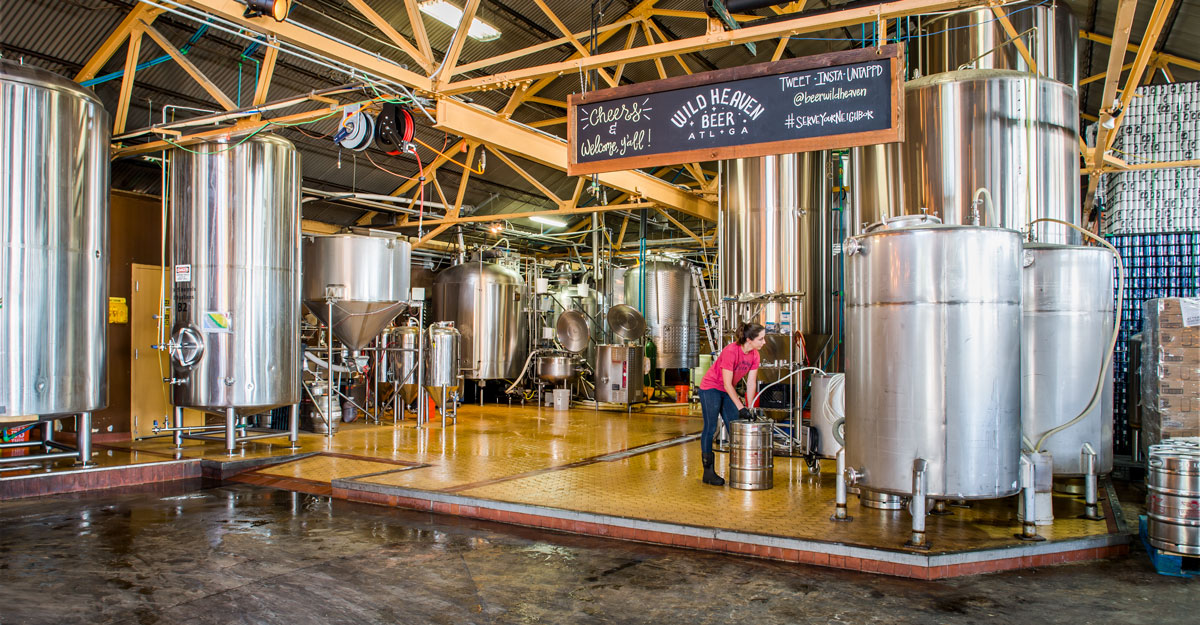TagsAvondale EstatesbeerCraft BeerdrinksGeorgia beerIPAlocal beerWild Heaven Beer
Home How is craft beer made?
The Rise of Georgia Beer: Everything you need to know about our craft brew scene
How is craft beer made?

This year, Wild Heaven Beer in Avondale Estates will brew around 10,000 barrels—the equivalent of a little less than 1,000 gallons a day. As brewmaster Eric Johnson says, “We don’t make beer. We make sugar water. The yeast makes the beer.” Johnson reckons that the yeast and the filtered water—tweaked to adjust the pH level—together account for at least 80 percent of the finished beer’s flavor.
The fundamentals of brewing haven’t really changed in 4,000 years. Beermaking starts by milling malted barley and occasionally other grains, such as rye or wheat. “Malted” means the germinated kernels have been heated quickly to kill them, then toasted. The longer the toast, the darker the beer. Milling, or crushing, the grains frees up the enzymes that will convert the seed’s starches to sugars.
Milled grains go from the grist case to the mash/lauter tun, where the grain is mixed with hot water. There, the sugars begin emerging. A screen at the bottom of the tank catches the grain residue. The liquid moves on to the kettle, where it’s brought to a boil. It’s at this point that hops and other flavoring ingredients, such as orange peel, are added. After about 90 minutes, the liquid, called wort, moves to the whirlpool, which further separates out any solids that still remain. Meanwhile, the wort is cooled through a heat exchange.
The wort is then piped through the bottom of one of seven fermenters. As the wort fills the tank, it travels through the yeast, which brewers have pitched at the bottom of the fermenter. The yeast eats the sugars, creating alcohol. At this stage, Johnson will add other ingredients depending on the beer—coffee grounds, say, for Ode to Mercy brown ale. The beer can sit in a fermenter between seven and 20 days. The fermenter above holds 30 barrels of beer; the biggest at Wild Heaven is four times that size, which is where the brewery’s flagship, Emergency Drinking Beer, is fermented.* Because Wild Heaven can brew just 30 barrels at a time, it takes four batches to fill up the biggest fermenter.
Once the beer has fermented, it’s moved to one of five bright tanks, where the beer is chilled and carbonated and remains until it’s time for kegging or canning. Like most Georgia breweries, Wild Heaven has moved almost exclusively to cans. Empty cans arrive on pallets holding 21 layers of them, enough to fill 350 cases. The canning line can fill roughly 2,400 cans—100 cases—per hour. Kegs are also filled from the bright tanks, either by machine or manually, as employee Mollie Meredith is doing in the photo. (Wild Heaven also ages specialty beers in casks.)
All beer begins life as small-scale experiments. Wild Heaven’s latest IPA, Altair, went through more than 50 iterations on Johnson’s one-barrel system Altair is Johnson’s answer to the hazy IPA craze. But compared to the beers Wild Heaven started out brewing eight years ago—almost exclusively high-gravity (alcohol) beers—much has changed. Emergency Drinking Beer, a light-drinking pilsner style, accounts for almost half of the brewery’s output. As Johnson says, “Sales drives production.”
* Wild Heaven is offloading production of Emergency Drinking Beer to Brew Hub, a Lakeland, Florida–based contract brewer. The arrangement frees up capacity at Wild Heaven’s brewery in Avondale Estates, as well as their expansion to the BeltLine’s Westside trail, expected to open this fall with a seven-barrel brewing system and an annual production of 2,000 barrels.





![The North Carolina Museum of Natural Sciences’ newest exhibit is a [pre]historic first](https://cdn2.atlantamagazine.com/wp-content/uploads/sites/4/2024/04/DD-3-100x70.jpg)



